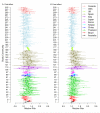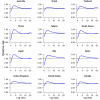Global variation in the effects of ambient temperature on mortality: a systematic evaluation
- PMID: 25166878
- PMCID: PMC4180721
- DOI: 10.1097/EDE.0000000000000165
Global variation in the effects of ambient temperature on mortality: a systematic evaluation
Abstract
Background: Studies have examined the effects of temperature on mortality in a single city, country, or region. However, less evidence is available on the variation in the associations between temperature and mortality in multiple countries, analyzed simultaneously.
Methods: We obtained daily data on temperature and mortality in 306 communities from 12 countries/regions (Australia, Brazil, Thailand, China, Taiwan, Korea, Japan, Italy, Spain, United Kingdom, United States, and Canada). Two-stage analyses were used to assess the nonlinear and delayed relation between temperature and mortality. In the first stage, a Poisson regression allowing overdispersion with distributed lag nonlinear model was used to estimate the community-specific temperature-mortality relation. In the second stage, a multivariate meta-analysis was used to pool the nonlinear and delayed effects of ambient temperature at the national level, in each country.
Results: The temperatures associated with the lowest mortality were around the 75th percentile of temperature in all the countries/regions, ranging from 66th (Taiwan) to 80th (UK) percentiles. The estimated effects of cold and hot temperatures on mortality varied by community and country. Meta-analysis results show that both cold and hot temperatures increased the risk of mortality in all the countries/regions. Cold effects were delayed and lasted for many days, whereas heat effects appeared quickly and did not last long.
Conclusions: People have some ability to adapt to their local climate type, but both cold and hot temperatures are still associated with increased risk of mortality. Public health strategies to alleviate the impact of ambient temperatures are important, in particular in the context of climate change.
Figures





References
-
- Martin SL, Cakmak S, Hebbern CA, Avramescu ML, Tremblay N. Climate change and future temperature-related mortality in 15 Canadian cities. International journal of biometeorology. 2012;56(4):605–19. - PubMed
-
- Tawatsupa B, Dear K, Kjellstrom T, Sleigh A. The association between temperature and mortality in tropical middle income Thailand from 1999 to 2008. International journal of biometeorology. 2014;58:203–215. - PubMed
-
- Curriero FC, Heiner KS, Samet JM, Zeger SL, Strug L, Patz JA. Temperature and mortality in 11 cities of the eastern United States. American Journal of Epidemiology. 2002;155(1):80–87. - PubMed
MeSH terms
Grants and funding
LinkOut - more resources
Full Text Sources
Other Literature Sources
Medical

